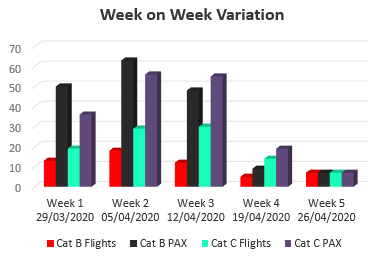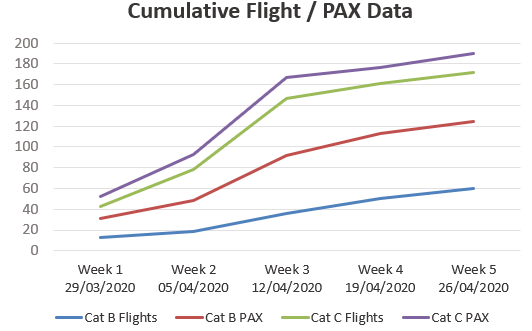
2020 arrived with a much-needed feeling of optimism and positivity throughout the industry. The long anticipated, planned Forties Pipeline Shutdown (FPS) presented the optimum opportunity for many Operators to align their summer shutdown campaigns and engineering project scopes to coincide.
Step Change in Safety had tailored some of its planned activities to support the forecasted increase in manning levels that would be required to support these 2020 programs. Topics frequently being discussed included; Connected Competence, Competence Assurance, Safe Working Essentials and the evergreen practice of sharing Safety Alerts and Moments. Increased focus was to be applied to heightening workforce awareness of the risks associated with Hydrocarbon Releases (HCR) prior to post shutdown start-ups.
COVID-19 had not yet become a mainstream topic of discussion but that would all change on the 14th February when the first suspected case offshore was reported, followed soon after by the first COVID-19 case on mainland Scotland confirmed on the 1st March.
Recognising the potential impact COVID-19 could have across the offshore sector, Step Change in Safety launched the first of its COVID-19 workforce engagement video packs on the 17th March. These videos were specifically aimed at increasing awareness about the potential impact COVID-19 could have on safety offshore, and what should be done to mitigate this potential.
On the 23rd March, the UK Prime Minister Boris Johnson announced that the UK would be placed into “lock down” for at least three weeks, and then extended the lockdown for another three weeks. Government guidelines confirmed that oil and gas workers were in the Key/Essential Worker category and, as such, would be exempt from the lockdown.
Like other businesses deemed to be exempt, the oil and gas sector had to assess how it would mitigate the potential transmission of the virus, while also adhering to the Government’s social distancing (SD) guidelines.
These guidelines, by their very nature, were far too vague to be easily applied in the offshore environment. This immediately raised concerns within the workforce and their families, many challenged the key/essential work status and the application of the SD guidelines. The very nature by which the oil and gas workforce routinely travels from home to heliport and onwards to their place of work is not typically conducive with SD guidelines. Time spent working and living offshore also presents its own challenges regarding SD and isolation of those presenting symptoms.
Immediate action was required, with OGUK taking the lead in establishing a Pandemic Steering Group and an Incident Management Team. Within day, heliport temperature checks were introduced, supported by pre-check in questionnaires. This met both the Health Protection England and Scotland (HPE&S) guidelines however, in the minds of the workforce and their families, these were not specific enough for the offshore sector.
The dynamic situation was changing daily as it became apparent that a number of installations were now reporting the presence of workers with COVID-19 symptoms. Table one provides details of how these cases are classified and what action should be taken to get them home.
|
Since the onset of social distancing, the oil and gas industry has introduced many additional measures both on and offshore all aimed at reducing the transmission of the virus. Both Step Change in Safety and OGUK created COVID-19 information hubs on their websites to provide details of these measures and good practice. It is worth noting that these measures go well beyond the expectations of the Government and both Health Protection Scotland and Health Protection England guidelines. They demonstrate that, as an industry, we will go the extra mile when it comes to protecting our workforce.
At the time of going to press the COVID-19 flight statistics suggest that the measures introduced have had a positive impact, (see charts one & two,) on reducing the volume of COVID-19 related inward flights and passenger numbers.


This is encouraging data which, in the main, tells us that through working together with our workforce we have significantly reduced the transmission rate. That said, we recognise that there is still more that can – and will – be done to further reduce the transmission rates of COVID-19. As we go to Press, the use of snoods is being introduced along with the facility for offshore workers and their families to be tested for COVID-19 should they be presenting with symptoms. Every effort has been made to ensure these additional measures do not impact on the availability of screening and PPE needs of frontline workers.
We will continue to respond to the concerns of the workforce by maintaining frequent and factual updates which will include statistical updates on a monthly basis. It’s also important to remind everyone that this will be a lengthy journey, that will continue to test our resilience and resolve, which will require us all to continue to work together.
Step Change in Safety has been working closely with OGUK and the wider industry, taking up the role of providing workforce engagement and communication.
The online COVID-19 information hub – which is made up of two dedicated sites on the Step Change in Safety and OGUK websites – with guidance, videos and FAQs was launched to provide everyone involved in the industry, and their families, with a “one-stop shop” to address concerns on the prevention and protection against coronavirus in around 150 manned installations across the UK Continental Shelf (UKCS) and the substantial onshore workforce. Both organisations are working jointly to provide the most accurate information about topics and services such as offshore helicopter travel, health screening and training re-certification.
www.stepchangeinsafety.net/covid-19
www.oilandgasuk.co.uk/covid-19
Recommended for you
